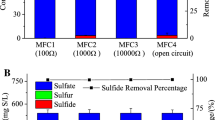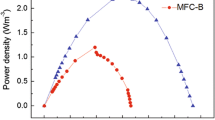Abstract
This study determined the influence of substrate degradation on power generation in microbial fuel cells (MFCs) and microbial community selection on the anode. Air cathode MFCs were fed synthetic medium containing different substrates (acetate, glucose and starch) using primary clarifier sewage as source of electroactive bacteria. The complexity of the substrate affected the MFC performance both for power generation and COD removal. Power output decreased with an increase in substrate complexity from 99 ± 2 mW m−2 for acetate to 4 ± 2 mW m−2 for starch. The organic matter removal and coulombic efficiency (CE) of MFCs with acetate and glucose (82% of COD removal and 26% CE) were greater than MFCs using starch (60% of COD removal and 19% of CE). The combined hydrolysis–fermentation rate obtained (0.0024 h−1) was considerably lower than the fermentation rate (0.018 h−1), indicating that hydrolysis of complex compounds limits current output over fermentation. Statistical analysis of microbial community fingerprints, developed on the anode, showed that microbial communities were enriched according to the type of substrate used. Microbial communities producing high power outputs (fed acetate) clustered separately from bacterial communities producing low power outputs (fed complex compounds).







Similar content being viewed by others
References
Abasiekong SF (1991) Effects of fermentation on crude protein content of brewers dried grains and spent sorghum grains. Bioresour Technol 35(1):99–102
Andreesen JR, Schaupp A, Neurauter C, Brown A, Ljungdahl LG (1973) Fermentation of glucose, fructose, and xylose by Clostridium thermoaceticum: effect of metals on growth yield, enzymes, and the synthesis of acetate from CO2. J Bacteriol 114(2):743–751
APHA (1995) Standard methods for examination of water and wastewater Clescerl LS, Greenberg AE, Eaton AD (eds) American Public Health Association, Washington, DC
Arvidson S (1973) Hydrolysis of casein by three extracellular proteolytic enzymes from Staphylococcus aureus, strain v8. Acta Pathologica Microbiologica Scandinavica 81B(5):538–544
Catal T, Li K, Bermek H, Liu H (2008) Electricity production from twelve monosaccharides using microbial fuel cells. J Power Sources 175(1):196–200
Cheng S, Liu H, Logan BE (2006) Increased power generation in a continuous flow MFC with advective flow through the porous anode and reduced electrode spacing. Environ Sci Technol 40(7):2426–2432
Clarke K, Warwick R (2001) Change in marine communities: an approach to statistical analysis and interpretation. PRIMER-E, Plymouth
Du Z, Li H, Gu T (2007) A state of the art review on microbial fuel cells: a promising technology for wastewater treatment and bioenergy. Biotechnol Adv 25(5):464–482
Gray ND, Brown A, Nelson DR, Pickup RW, Rowan AK, Head IM (2007) The biogeographical distribution of closely related freshwater sediment bacteria is determined by environmental selection. ISME J 1(7):596–605
Gujer W, Zehnder AJB (1983) Conversion processes in anaerobic digestion. Water Sci Technol 15:127–167
Jung S, Regan J (2007) Comparison of anode bacterial communities and performance in microbial fuel cells with different electron donors. Appl Microbiol Biotechnol 77(2):393–402
Kataeva IA, Seidel RD III, Shah A, West LT, Li X-L, Ljungdahl LG (2002) The fibronectin type 3-like repeat from the Clostridium thermocellum cellobiohydrolase CbhA promotes hydrolysis of cellulose by modifying its surface. Appl Environ Microbiol 68(9):4292–4300
Katuri KP, Scott K, Head IM, Picireanu C, Curtis TP (2011) Microbial fuel cells meet with external resistance. Bioresour Technol 102(3):2758–2766
Kim BH, Park HS, Kim HJ, Kim GT, Chang IS, Lee J, Phung NT (2004) Enrichment of microbial community generating electricity using a fuel-cell-type electrochemical cell. Appl Microbiol Biotechnol 63(6):672–681
Kim N, Choi Y, Jung S, Kim S (2000) Effect of initial carbon sources on the performance of microbial fuel cells containing Proteus vulgaris. Biotechnol Bioeng 70(1):109–114
Lalaurette E, Thammannagowda S, Mohagheghi A, Maness P-C, Logan BE (2009) Hydrogen production from cellulose in a two-stage process combining fermentation and electrohydrogenesis. Int J Hydrogen Energy 34(15):6201–6210
Lavarack BP, Griffin GJ, Rodman D (2000) Measured kinetics of the acid-catalysed hydrolysis of sugar cane bagasse to produce xylose. Catal Today 63(2–4):257–265
Lee H-S, Parameswaran P, Kato-Marcus A, Torres CI, Rittmann BE (2007) Evaluation of energy conversion efficiencies in microbial fuel cells utilizing fermentable and non-fermentable substrates. Water Res 42(6–7):1501–1510
Logan BE (2009) Exoelectrogenic bacteria that power microbial fuel cells. Nat Rev Micro 7(5):375–381
Mackenzie CR, Bilous D, Patel GB (1985) Studies on cellulose hydrolysis by Acetivibrio cellulolyticus. Appl Environ Microbiol 50(2):243–248
Mata-Alvarez J, Macé S, Llabrés P (2000) Anaerobic digestion of organic solid wastes. An overview of research achievements and perspectives. Bioresour Technol 74(1):3–16
Matsubara N, Yotsuji A, Kumano K, Inoue M, Mitsuhashi S (1981) Purification and some properties of a cephalosporinase from Proteus vulgaris. Antimicrob Agents Chemother 19(1):185–187
Metcalf and Eddy (2003) Wastewater engineering: treatment and reuse. Mc Graw Hill, New York, pp 630–631
Min B, Logan BE (2004) Continuous electricity generation from domestic wastewater in a flat plate microbial fuel cell. Environ Sci Technol 38(21):5809–5814
Niessen J, Schroder U, Scholz F (2004) Exploiting complex carbohydrates for microbial electricity generation—a bacterial fuel cell operating on starch. Electrochem Commun 6(9):955–958
Pham TH, Aelterman P, Verstraete W (2009) Bioanode performance in bioelectrochemical systems: recent improvements and prospects. Trends Biotechnol 27(3):168–178
Rabaey K, Boon N, Siciliano SD, Verhaege M, Verstraete W (2004) Biofuel cells select for microbial consortia that self-mediate electron transfer. Appl Environ Microbiol 70(9):5373–5382
Rezaei F, Richard TL, Logan BE (2008) Enzymatic hydrolysis of cellulose coupled with electricity generation in a microbial fuel cell. Biotechnol Bioeng 101(6):1163–1169
Sharma Y, Li B (2010) The variation of power generation with organic substrates in single-chamber microbial fuel cells (SCMFCs). Bioresour Technol 101:1844–1850
Thygesen A, Poulsen FW, Min B, Angelidaki I, Thomsen AB (2009) The effect of different substrates and humic acid on power generation in microbial fuel cell operation. Bioresour Technol 100(3):1186–1191
Torres CI, Kato Marcus A, Rittmann BE (2007) Kinetics of consumption of fermentation products by anode-respiring bacteria. Appl Microbiol Biotechnol 77(3):689–697
van Lier JB, Tilche A, Ahring BK, Macarie H, Moletta R, Dohanyos M, Pol LWH, Lens P, Verstraete W (2001) New perspectives in anaerobic digestion. Water Sci Technol 41(1):1–18
van Verseveld HW, Roling WFM (2008) Cluster analysis and statistical comparison of molecular community profile data. In: Kowalchuk GA, FJd B, Head IM, Akkermans AD, JDv E (eds) Molecular microbial ecology manual. Springer, London, pp 1373–1397
Vavilin VA, Fernandez B, Palatsi J, Flotats X (2008) Hydrolysis kinetics in anaerobic degradation of particulate organic material: an overview. Waste Manage 28(6):939–951
Velasquez-Orta S, Head IM, Curtis TP, Scott K, Lloyd J, Canstein H (2010) The effect of flavin electron shuttles in microbial fuel cells current production. Appl Microbiol Biotechnol 85(5):1373–138
Vogel HC (1983) Fermentation and biochemical engineering handbook. Noyes, New Jersey, pp 1–46
Xing D, Cheng S, Regan JM, Logan BE (2009) Change in microbial communities in acetate- and glucose-fed microbial fuel cells in the presence of light. Biosens Bioelectron 25(1):105–111
Xue F, Zhang X, Luo H, Tan T (2006) A new method for preparing raw material for biodiesel production. Process Biochem 41(7):1699–1702
Zhang Y, Min B, Huang L, Angelidaki I (2011) Electricity generation and microbial community response to substrate changes in microbial fuel cell. Bioresour Technol 102(2):1166–1173
Acknowledgements
This research was supported by the Mexican Research Council for Science and Technology (CONACyT), PhD contract 196298.
Author information
Authors and Affiliations
Corresponding author
Rights and permissions
About this article
Cite this article
Velasquez-Orta, S.B., Yu, E., Katuri, K.P. et al. Evaluation of hydrolysis and fermentation rates in microbial fuel cells. Appl Microbiol Biotechnol 90, 789–798 (2011). https://doi.org/10.1007/s00253-011-3126-5
Received:
Revised:
Accepted:
Published:
Issue Date:
DOI: https://doi.org/10.1007/s00253-011-3126-5




